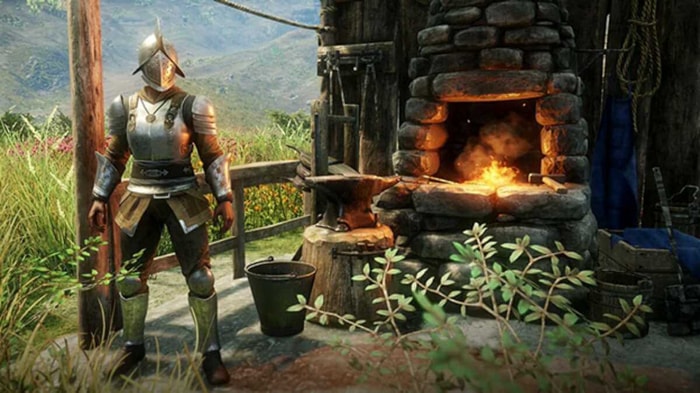In the New World game, armoring falls under crafting skills. Through armoring, you can create multiple types of armor, such as light, medium, or heavy armor.
Another significant benefit of armoring is the ability to make and trade Storage Bags or use them to expand your inventory. Additionally, you may make balms, gloves, pants, boots, hats, and shirts.
There are various community stations where different armor forms are made. Forges and Outfitting Stations are the two primary locations for armoring. These specific Trade Skill Stations are located in each game's significant Settlements.
For materials and resources, the armoring skill is dependent on other skills. In addition to trade, you can obtain the supplies needed for crafting from other players.
Players can buy essential things at trade stations using the main in-game currency known as New World Gold, generally referred to as "coins," or on certain platforms like MmoGah.
Even the strongest heroes will perish fast if they don't have the proper armor and attire. Therefore, choosing these items cautiously is crucial in the game or your character. Everything from a linen shirt to an iron breastplate can be made with armoring.
It may be more complex to utilize the Armoring skill to create linen and sateen clothing at an outfitting station than to generate iron armor at a forge.
You will need to collect many materials to create to start armoring and advance your armoring skill; these materials will include a lot of ore, both raw and processed into ingots, cloth, leather supplies, etc.
As a result, you should invest as much time as possible in honing your gathering trade skills, especially in mining, tracking and skinning, and harvesting. Pay close attention to your Refining Trade Skills, especially those related to weaving, leatherworking, and smelting.
After gathering the necessary materials, you will use the Outfitting Station to create light and medium armor, storage bags, and a forge to create heavy armor in the New World.
The type of armor you should wear entirely depends on your character's physical characteristics and play style. You can protect yourself with thicker defensive armor, which may slow you down, or you can optimize your dodge at the expense of your natural defense. As for optimum armor, different weapons and playing styles will be based on various preferences.
Players generally progress in various ways when they level up skills through grinding in most RPGs. The same is true of New World's armoring. The initial step in character leveling is to acquire experience points (XP) through various methods, allowing you to enhance your qualities.
The rewards of increasing one's armoring skills are numerous. It will assist you in creating more robust, better armor. The odds of receiving the perks and gems are increased by leveling up the armoring.
More recipes will become available as your level rises. The more potent variations of the already existing recipes will also be unlocked in addition to the additional recipes. You should keep leveling up until you reach the maximum level of 200.
The Brimstone Sands patch in the New World brought about several changes. Thanks to their first-time craft bonus program, you now get twice as much experience making an item. For instance, you gain 200 experience points instead of 100 the first time you craft an item like a linen glove.
Although this adjustment is significant for all trade skills, armoring is particularly affected because so many different types of armor may be made. You can reach level 50 without creating two of the same item by beginning to craft each piece of armor at level 0. Therefore, benefit from these free experience points.
Town board tasks will continue to offer a worthwhile armoring experience for inexpensive resources. The town board armoring tasks are a supplement to your regular leveling procedure. While salvaging items, the ideal salvage method also gives you a free armoring experience. Use this strategy to your advantage to make leveling simpler. Additionally, gloves continue to offer the most experience for the fewest resources required. While you are leveling up, it is advised to craft them.
The expedition armor replicas from Genesis and Lazarus can be crafted once you reach level 160. The quantity of experience gained from these replicas per resource is enormous. The challenge is finding the expedition supplies required to make them, though. The best way to level armor is to gather the supplies needed for crafting, including leather, linen, iron ingots, etc.
The materials panel, which lists the necessary resources, may be seen in the game's crafting interface in the center of the screen. For each object to be created, a primary and, at minimum, one secondary material is required.
Additionally, if you wish to predetermine the first perk you want to add to the item, you can add a specific bonus. You can also include Azoth to raise your chances of receiving a perk.
Although the outcome is entirely random, and you're only sometimes sure to obtain the one you want, the more Azoth you pay, the greater your odds. The tier of the armor also places a cap on how much Azoth you can add.
Tier 2 Metals, Refined Wood, Leather, and a few unique resources are additional materials that can be added.
Resources:

Specific resources are required to help you level Armoring quickly and efficiently at the different levels; some of these resources include:
Cloth:
Cloth is one vital resource you'll need, but you first need hemp fibers to make cloth. You must have a level 25 in harvesting to obtain hemp fibers. Finding as much hemp as possible and producing cloth at the loom should be straightforward and quick if you have that Harvesting level 25.
Coarse Leather:
Rawhide is refined in a leatherworking station to create coarse leather. The primary concept is to cultivate rawhide from wolves because they drop the most compared to how long it takes to kill and skin them. It is the simplest way to obtain all the coarse leather you require.
Iron Ingots:
We also require iron ingots as a resource. You must level up your mining skill to level 25 to do this. Once you have a large quantity of iron, producing iron ingots at a smelter is a simple process.
Sateen:
You need some cloth weave and linen to get sateen. The first is cross-weave, which is exclusively available from overworld supply crates, containers, and chests.
You can also use wire weave or silk weave, which both require a master material converter and Tier 5 crafting materials. Silkweave requires an advanced material converter.
Silk:
This calls for silk strands, which must be obtained from silkweed plants and refined at a loom, as well as sateen and cross-weave fabrics. You require a Harvesting skill of 100 to collect silkweed.
Linen Shirt:
Although this cloth armor is very mobile, it only offers modest protection. Making many linen shirts is an excellent place to start when leveling armoring.
The easiest to construct are linen shirts, which yield the same amount of crafting experience points as all other basic armor. Nevertheless, they still require a lot of resources.
Cloth, coarse leather, and ingots are used to create linen shirts.
Sateen Pants:
Iron ingots, coarse leather, and sateen are used to make sateen pants or leggings. To level up your armoring talent, this will give you more experience points than a linen shirt.
Silk Gloves:
These are made from iron ingots, coarse leather, and silk and aid with leveling.
Infused Silk Gloves:
You should make infused silk gloves if you seek to reach Level 200 Armoring. These are simple to make because they only need wire fiber, silk, and cross-weave. The only new resource is wire fiber, obtained from wire plants.
Leveling:

You are not constrained to using any specific approach to reach the maximum armoring of 200. It is anticipated that your strategy will alter following the availability of materials and market pricing values and that item costs will vary from server to server and occasionally change.
Although upgrading from one level to the next calls for a distinct strategy, the following is advised for effective leveling:
Level 0 - 50:
It would be best if you constructed a variety of goods, each of which awards the same number of XP points, to reach Armoring level 50. Consequently, the material-to-XP ratio is the same for all items.
Making the item with the best material ratio only makes sense in this situation. Of all the products that can be made, linen shirts have the best iron-to-fiber ratio. The Linen Shirt is the most straightforward item to create at level 0 regarding gathering resources. As an alternative, you can make Coarse Leather Gloves or Linen Handwraps.
To make linen hand wraps, you need four linen, four coarse leather, and one iron ingot. Alternatively, you can use the same materials to make coarse leather gloves. You will need a total of about 11,995 XP to reach level 50.
Level 50 - 100:
As your leveling progresses, it's crucial to start making better-tier armor. This has various advantages over creating lower-tier armor, such as the following:
You can raise your yield rate each time you improve a resource. You can make considerably more sateen out of your linen, for instance, if you have a respectable level of weaving skill and use high-tier cross-weave.
For example, you will use fewer rawhide and iron as secondary materials. Additionally, you can recover some elements from your handcrafted items to get higher-tier fabrics like silk and infused silk back.
About 139,624 experience points are required to advance from level 50 to 100. Crafting Sateen Gloves or Rugged Leather Gloves is advised for leveling this tier. Only iron, coarse leather, and linen are needed for this. Finding all of these resources is relatively easy.
Level 100 - 150:
Along with the sateen clothing, the silk clothing is unlocked at level 100. With so many alternatives, picking a cloth to construct at this stage can be challenging, but the Silk Gloves come highly recommended.
For silk gloves, head to the Tier 3 Crafting location to receive the necessary quantity of Silk Gloves once you have collected all the materials needed to make the Silk Gloves.
Between level 100 and level 150, around 986,580 experience points are needed. The leveling at this stage will resemble Tier 3 crafting. Layered leather gloves are an alternative, and layered leather, coarse leather, and ingots are among the materials used.
Completing this stage means you have successfully reached Armoring Level 150 in New World.
Level 150 - 200:
You virtually reach the end when you reach level 150, at which point you unlock all the crafting-able goods. However, the Infused Silk Gloves will be the main item you require and utilize to attain the maximum Armoring level of 200.
The explanations are straightforward: first, it is very affordable; second, the tax on creating it is also low. Before making the Infused Silk Gloves, it's suggested that you make any other items you might require and then figure out how many gloves you will need to craft.
You might be surprised by how much XP you need to gain to level 200 if you thought level 150 required a lot. You will require roughly 5,046,300 XP points to advance to Armoring level 200 in New World.
The Infused Silk Glove is easy to make using the necessary supplies, which is good news. You receive roughly 6,075 XP Points for each glove. Silk threads and WireFiber are two resources you'll need for armoring with a 200+ rating.
You can keep gaining experience points and aptitude levels after you've achieved the highest level. You will receive three reward boxes for each Armoring Aptitude Level.
Completing your armor quest requires the entire armor set. You can get this set in Brimstone Sands in various methods, but farming the mobs that drop the gear is the quickest method.
Conclusion
Following this guide, you can quickly get the New World's maximum armoring skill level of 200. The ultimate goal is to create durable armor for your usage and enjoyment in the game.



